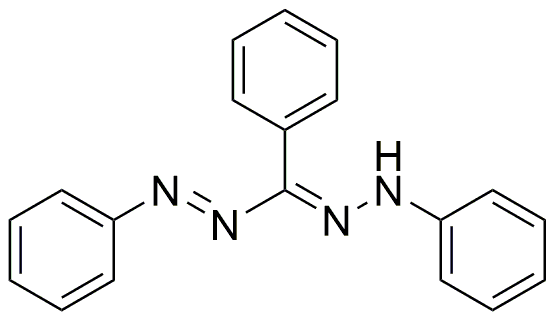1,3,5-Triphenylformazan is widely utilized in research focused on:
- Analytical Chemistry: This compound serves as a colorimetric reagent for the detection of metal ions, allowing researchers to quantify trace metals in various samples effectively.
- Biochemistry: It is used in assays to evaluate the activity of enzymes, providing insights into metabolic processes and potential drug interactions.
- Material Science: The compound is incorporated into polymer matrices to enhance their thermal and mechanical properties, making them suitable for advanced applications in coatings and composites.
- Pharmaceutical Development: It plays a role in the synthesis of novel pharmaceutical compounds, contributing to the discovery of new therapeutic agents.
- Environmental Monitoring: This chemical is employed in the analysis of pollutants, helping industries comply with environmental regulations by monitoring contaminants in air and water.
General Information
Properties
Safety and Regulations
Applications
1,3,5-Triphenylformazan is widely utilized in research focused on:
- Analytical Chemistry: This compound serves as a colorimetric reagent for the detection of metal ions, allowing researchers to quantify trace metals in various samples effectively.
- Biochemistry: It is used in assays to evaluate the activity of enzymes, providing insights into metabolic processes and potential drug interactions.
- Material Science: The compound is incorporated into polymer matrices to enhance their thermal and mechanical properties, making them suitable for advanced applications in coatings and composites.
- Pharmaceutical Development: It plays a role in the synthesis of novel pharmaceutical compounds, contributing to the discovery of new therapeutic agents.
- Environmental Monitoring: This chemical is employed in the analysis of pollutants, helping industries comply with environmental regulations by monitoring contaminants in air and water.
Documents
Safety Data Sheets (SDS)
The SDS provides comprehensive safety information on handling, storage, and disposal of the product.
Product Specification (PS)
The PS provides a comprehensive breakdown of the product’s properties, including chemical composition, physical state, purity, and storage requirements. It also details acceptable quality ranges and the product's intended applications.
Certificates of Analysis (COA)
Search for Certificates of Analysis (COA) by entering the products Lot Number. Lot and Batch Numbers can be found on a product’s label following the words ‘Lot’ or ‘Batch’.
*Catalog Number
*Lot Number
Certificates Of Origin (COO)
This COO confirms the country where the product was manufactured, and also details the materials and components used in it and whether it is derived from natural, synthetic, or other specific sources. This certificate may be required for customs, trade, and regulatory compliance.
*Catalog Number
*Lot Number
Safety Data Sheets (SDS)
The SDS provides comprehensive safety information on handling, storage, and disposal of the product.
DownloadProduct Specification (PS)
The PS provides a comprehensive breakdown of the product’s properties, including chemical composition, physical state, purity, and storage requirements. It also details acceptable quality ranges and the product's intended applications.
DownloadCertificates of Analysis (COA)
Search for Certificates of Analysis (COA) by entering the products Lot Number. Lot and Batch Numbers can be found on a product’s label following the words ‘Lot’ or ‘Batch’.
*Catalog Number
*Lot Number
Certificates Of Origin (COO)
This COO confirms the country where the product was manufactured, and also details the materials and components used in it and whether it is derived from natural, synthetic, or other specific sources. This certificate may be required for customs, trade, and regulatory compliance.


